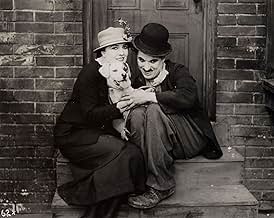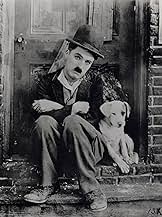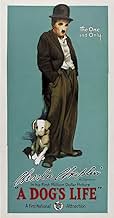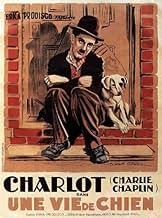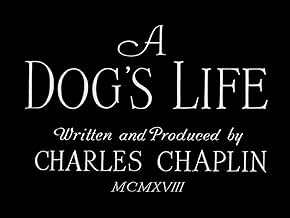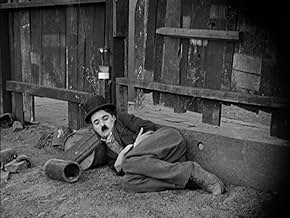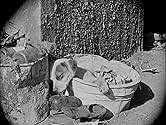VALUTAZIONE IMDb
7,6/10
10.306
LA TUA VALUTAZIONE
Aggiungi una trama nella tua linguaThe Little Tramp and his dog companion struggle to survive in the inner city.The Little Tramp and his dog companion struggle to survive in the inner city.The Little Tramp and his dog companion struggle to survive in the inner city.
Edna Purviance
- Bar Singer
- (non citato nei titoli originali)
Dave Anderson
- Bartender
- (non citato nei titoli originali)
Bert Appling
- Unemployed Man
- (non citato nei titoli originali)
Albert Austin
- Crook
- (non citato nei titoli originali)
Henry Bergman
- Fat Unemployed Man
- (non citato nei titoli originali)
- …
Alva D. Blake
- Man in Dance Hall
- (non citato nei titoli originali)
Mel Brown
- Employment Agency Clerk
- (non citato nei titoli originali)
- …
Minnie Chaplin
- Dance-Hall Dramatic Lady
- (non citato nei titoli originali)
Syd Chaplin
- Lunchwagon Owner
- (non citato nei titoli originali)
Dorothy Cleveland
- Woman in Dance Hall
- (non citato nei titoli originali)
Slim Cole
- Unemployed Man
- (non citato nei titoli originali)
Margaret Cullington
- Woman in Dance Hall
- (non citato nei titoli originali)
Billy Dill
- Man in Dance Hall
- (non citato nei titoli originali)
Margaret Dracup
- Woman in Dance Hall
- (non citato nei titoli originali)
Jack Duffy
- Man in Dance Hall
- (non citato nei titoli originali)
Robert Dunbar
- Old Man in Dance Hall
- (non citato nei titoli originali)
Ella Eckhardt
- Woman in Dance Hall
- (non citato nei titoli originali)
Recensioni in evidenza
Played as a double feature, A Dog's Life is the short comedy that played with one of Chaplin's famous and most adored comedies The Kid. Set in the same atmosphere of the depressing ghettos of 1918, The Tramp becomes friends with a stray dog. A lost soul much like himself, the Tramp and the tramp become friends and become a team. After finding a stolen loot, the two work together to re-take the money they found. The ending is cute and nothing more. For a short, it does the trick of making the audience laugh. The title indicated that this is the story of the dog, when in fact, the Dog is the Tramp! Both are homeless and without love in their lives. By the end of the movie, they both end up finding true love and end up living a better life, together.
In 'A Dog's Life' our little tramp takes care of dog, the nice touch in this movie. Other things are familiar. He encounters the police, he tries to steal food from a salesman, has money problems in a bar, has some trouble with two thugs and of course he gets the girl.
The best single moment in this short is when he pretends to be one of the two thugs. With perfect timing this a perfect piece of comedy and just this part makes the movie worth watching. There are other funny moments, especially with the dog's tale. A nice short that is a little too long. The very funny final moments (including the part with the two thugs) make sure we don't think about that too much.
The best single moment in this short is when he pretends to be one of the two thugs. With perfect timing this a perfect piece of comedy and just this part makes the movie worth watching. There are other funny moments, especially with the dog's tale. A nice short that is a little too long. The very funny final moments (including the part with the two thugs) make sure we don't think about that too much.
This film was one of three that were later combined by Chapin into a compilation that was released to theaters in the late 1950s under the title "The Chaplin Review".
Of the three films combined for The Chapline Review, this is probably the most familiar in style and, to me, the least interesting. While it is STILL a very good film, it just didn't seem all that new or different. We have the Little Tramp down on his luck and looking to feed himself when he stumbles upon a poor lonely dog being picked on by the other dogs. So, he adopts it and they both set out on some adventures. I know this may sound strange, but to me this film felt a lot like an earlier incarnation of THE KID--though of course in this case it's a cute mutt and not Jackie Coogan. A very good and entertaining short with no serious flaws.
Of the three films combined for The Chapline Review, this is probably the most familiar in style and, to me, the least interesting. While it is STILL a very good film, it just didn't seem all that new or different. We have the Little Tramp down on his luck and looking to feed himself when he stumbles upon a poor lonely dog being picked on by the other dogs. So, he adopts it and they both set out on some adventures. I know this may sound strange, but to me this film felt a lot like an earlier incarnation of THE KID--though of course in this case it's a cute mutt and not Jackie Coogan. A very good and entertaining short with no serious flaws.
This is an entertaining comedy with a couple of particularly amusing scenes. Chaplin is joined by several of his regular supporting players like Edna Purviance and Henry Bergman, plus Syd Chaplin, and the cast works together well. The story is funny, yet not without some substance either.
As his usual 'tramp' character, Charlie is already living "A Dog's Life" when he befriends a stray dog, and they share some adventures together. Chaplin hits a good balance in keeping himself and the dog sympathetic without overdoing the sentiment. There are some slow stretches that keep it from being even better, but the good parts make up for them and make this definitely worth watching. One particular highlight is a scene where Charlie tries to outwit two thieves - it's very cleverly done and very funny.
Anyone who likes Chaplin's comedies should enjoy this one. It has good comedy, a talented and familiar cast, and some worthwhile material - just about everything you would expect in one of Chaplin's features.
As his usual 'tramp' character, Charlie is already living "A Dog's Life" when he befriends a stray dog, and they share some adventures together. Chaplin hits a good balance in keeping himself and the dog sympathetic without overdoing the sentiment. There are some slow stretches that keep it from being even better, but the good parts make up for them and make this definitely worth watching. One particular highlight is a scene where Charlie tries to outwit two thieves - it's very cleverly done and very funny.
Anyone who likes Chaplin's comedies should enjoy this one. It has good comedy, a talented and familiar cast, and some worthwhile material - just about everything you would expect in one of Chaplin's features.
Just like his little tramp alter ego, Charlie Chaplin liked to think big, and had always aimed to extend the scale and scope of his pictures, never content to be a two-reel sideshow. At 35 minutes, A Dog's Life could hardly be described as his first full-length feature, but it arguably represents his break away from shorts.
Just the opening shot of A Dog's Life shows how Chaplin is starting to inject some grand sweep into his storytelling. The camera begins amid city rooftops, tilting down to reveal Charlie sleeping amid the rubbish behind a ramshackle fence. The way this purpose-built set is shot demonstrates how Chaplin was as much a "proper" director as a comic. He several times has a shabby sign advertising "rooms" visible in the background – a subtle reminder that the tramp is too poor even for the cheapest accommodation.
It's a nice touch how Charlie's canine friend is introduced in a handful of cutaways during this opening scene – treating him as a real character rather than just a plot device. But this is not to the detriment to his human companions, and indeed leading lady Edna Purviance gets a more substantial part than she did in many of the shorts. She makes a really great character here, giving an impression of a naïve but feisty youngster, certainly more than just a token female. It's this kind of characterisation that gives A Dog's Life the kind of comprehensive structure of a feature film, as opposed to a comedy short in which people just turn up on screen for a bit of funny business.
On a quick side-note, this is the earliest Chaplin picture which features a score written by him (although since he wrote the music in retrospect some decades later it's not the first he wrote). It's another testament to the breadth of his genius, showing both considerable musical ability as well as his own irreverent personality. Numbers like the dance hall rag are of course very "silent comedy", but pieces like the opening theme have a truly deep and epic feel to them. Even here though, the Chaplin cheekiness shines through, with different parts of the orchestra playing off each other in a kind of question-and-answer routine.
Chaplin would repeat this "little companion" routine, swapping dog for tot in his first genuine full-length feature The Kid. A Dog's Life remains a worthy predecessor, part of the comedian's ever upward trajectory at this point in his career. It would take more battling with studio heads for Chaplin to get his ideas fully realised, but it was pictures like this that began to get silent comedy taken seriously.
Just the opening shot of A Dog's Life shows how Chaplin is starting to inject some grand sweep into his storytelling. The camera begins amid city rooftops, tilting down to reveal Charlie sleeping amid the rubbish behind a ramshackle fence. The way this purpose-built set is shot demonstrates how Chaplin was as much a "proper" director as a comic. He several times has a shabby sign advertising "rooms" visible in the background – a subtle reminder that the tramp is too poor even for the cheapest accommodation.
It's a nice touch how Charlie's canine friend is introduced in a handful of cutaways during this opening scene – treating him as a real character rather than just a plot device. But this is not to the detriment to his human companions, and indeed leading lady Edna Purviance gets a more substantial part than she did in many of the shorts. She makes a really great character here, giving an impression of a naïve but feisty youngster, certainly more than just a token female. It's this kind of characterisation that gives A Dog's Life the kind of comprehensive structure of a feature film, as opposed to a comedy short in which people just turn up on screen for a bit of funny business.
On a quick side-note, this is the earliest Chaplin picture which features a score written by him (although since he wrote the music in retrospect some decades later it's not the first he wrote). It's another testament to the breadth of his genius, showing both considerable musical ability as well as his own irreverent personality. Numbers like the dance hall rag are of course very "silent comedy", but pieces like the opening theme have a truly deep and epic feel to them. Even here though, the Chaplin cheekiness shines through, with different parts of the orchestra playing off each other in a kind of question-and-answer routine.
Chaplin would repeat this "little companion" routine, swapping dog for tot in his first genuine full-length feature The Kid. A Dog's Life remains a worthy predecessor, part of the comedian's ever upward trajectory at this point in his career. It would take more battling with studio heads for Chaplin to get his ideas fully realised, but it was pictures like this that began to get silent comedy taken seriously.
Lo sapevi?
- QuizThis was Charles Chaplin's first film for First National Pictures under a $1M contract where Chaplin had full creative control over his films for the first time.
- BlooperDuring the fight at the lunch cart, one of the props holding up the awning gets knocked away. In subsequent shots, the prop is back in place.
- Citazioni
Title Card: When dreams come true.
- ConnessioniEdited into The Chaplin Revue (1959)
I più visti
Accedi per valutare e creare un elenco di titoli salvati per ottenere consigli personalizzati
Dettagli
- Data di uscita
- Paese di origine
- Siti ufficiali
- Lingue
- Celebre anche come
- A Dog's Life
- Luoghi delle riprese
- Azienda produttrice
- Vedi altri crediti dell’azienda su IMDbPro
- Tempo di esecuzione33 minuti
- Colore
- Mix di suoni
- Proporzioni
- 1.33 : 1
Contribuisci a questa pagina
Suggerisci una modifica o aggiungi i contenuti mancanti

Divario superiore
By what name was Vita da cani (1918) officially released in Canada in English?
Rispondi
